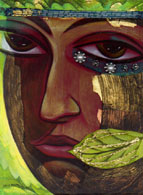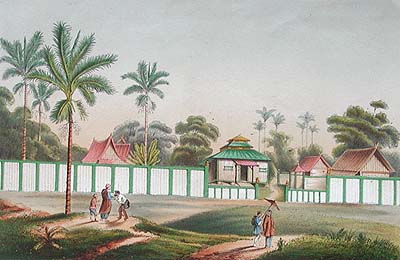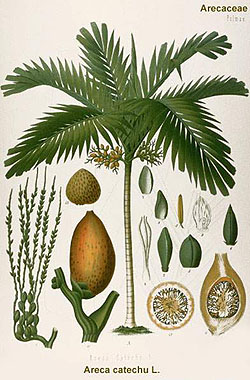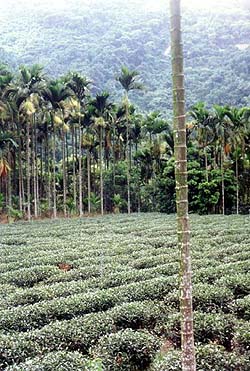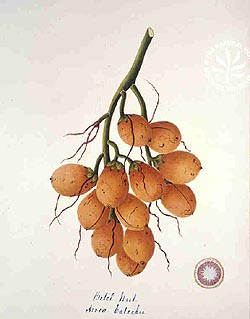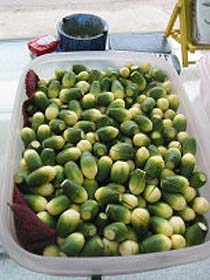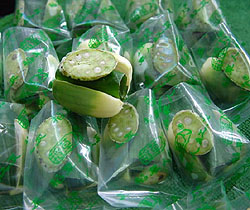|
|||||||||
|
|||||||||
|
(Click on image to read the Vietnamese myth) |
(Click on image for more about the betel-nut myth) |
||||||||
| The tradition had begun. Times would change on the island of Formosa as invaders came from the islands to the north and from the great land to the west but none was mightier than the nut. The chewing of the nut was to become a potent symbol of 'being Taiwanese', and was sufficiently widespread to be known as Taiwanese chewing gum. | |||||||||
|
(Click for full image) |
|||||||||
|
The Source The betel nut is the fruit of the Betel Palm (Areca catechu). The betel-nut tree today still grows in the verdant valleys of southern Taiwan but no longer does it need to be sought out in the dangerous forests. The ease of cultivation, the almost insatiable demand prior to Taiwan's entry into the World Trade Organization and the lure of money led to an ever greater encroachment of cleared land for areca cultivation. Mountain sides have been denuded to allow for illegal planting on the watersheds of this shallow-rooting palm that fails to bind the topsoil. In recent years, following the massive lethal mudslides in Nantou County of 2001 that were partially caused by the illegal planting of betel palms on slopeland, the government has sought to curb this practice. However, with few alternative cash crops the farmers have seen little incentive to change. |
|||||||||
|
Areca Catechu or Betel Palm (Click on image to enlarge) |
The shallow gravels, the climactic conditions and the plentiful
groundwater of the eastern part of the Pingtung plain have proved ideal
for the cultivation of the areca palm.
Yielding some three tonnes of nuts per hectare each year the crop of the areca palm has been termed as Taiwan's 'green gold'. The rich agricultural and financial harvest has drawn in both local farmers and local businessmen. |
Betel palms on the Pingtung foothills |
|||||||
|
Binlang
is chewed in a betel quid giving rise to the misnaming of the areca nut
as a 'betel nut'. The betel quid as chewed in Taiwan consists of three
basic elements: the areca nut itself; the leaf, and, uniquely in Taiwan,
the inflorescence, of the piper betel plant: and a paste of slaked lime.
Each of these elements has its own purpose and effect, but combine
together in the mouth to give the distinctive stimulation or 'high' of
the betel nut.
The areca nut contains two significant alkaloids. The main alkaloid is arecoline, which also causes the excessive salivation characteristic of betel-nut chewing. Two parts of the piper betel, a member of the piperaceae or pepper family, are used in Taiwan. The betel leaf contains a aromatic phenol, betel-phenol, and the inflorescence contains safrole. Although safrole is safely used as a food flavouring, it is thought to be a carcinogenic in larger amounts. |
|||||||||
|
The final component of the betel quid is slaked lime. In Taiwan two slaked lime pastes are used: the more palatable red paste, and the more efficacious white paste. The lime acts as a catalyst to draw out the arecoline, guvacoline and phenols into the saliva and thence into the bloodstream. As to the effects of binlang, you are probably best to try it for yourself. It is certainly not a stimulant that has the instant and gripping effect of amphetamine or cocaine. It is natural, and thus more akin to drinking coffee or tea, or chewing coca leaves. The effect is thus softer and subtle, giving a feeling of energy and yet well-being, offsetting hunger and fatigue, and bringing a warmth to the body that tempts so many young Taiwanese conscripts on early morning guard duty. |
Another fine botanical drawing of betel nuts (click to enlarge) |
||||||||
|
Betel leaves (Piper sarmentosum) |
Areca nuts ready for preparation |
Betel nuts prepared for sale |
|||||||
|
The strength of the
'green gold' merchants can be envisioned from the very size of the betel-nut, or
bin-lang, market. There are estimated to be over 2 million chewers of the nut on
Taiwan, which represents around a quarter of the adult male population. Annual
revenue is authoritatively given as 'nearly 100 billion NT dollars', and the
area under cultivation as 57,000 hectares.
An updated assessment of the betel-nut trade can be seen from this page of the Taipei Times. The trade in bin-lang is utterly unregulated and remains untaxed despite its economic importance. Such huge undocumented cash flows have attracted of the interest of people from all walks of life and the need to use creative marketing strategies. Foremost amongst the marketers of this product are the 'binlang girls' .... read on ! |
|||||||||
|
|||||||||

